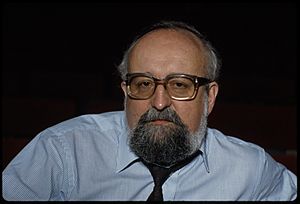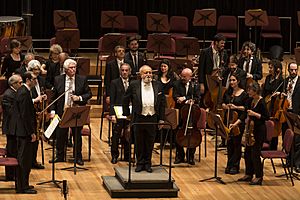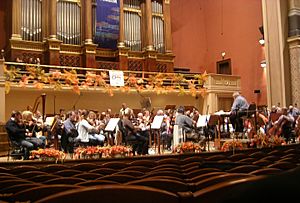Krzysztof Penderecki facts for kids
Quick facts for kids
Krzysztof Penderecki
|
|
|---|---|
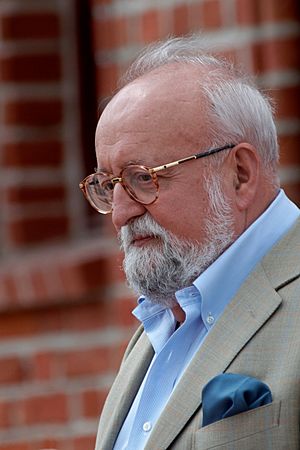 |
|
| Born |
Krzysztof Eugeniusz Penderecki
23 November 1933 Dębica
|
| Died | 29 March 2020 (aged 86) |
| Signature | |
Krzysztof Eugeniusz Penderecki (born November 23, 1933 – died March 29, 2020) was a famous Polish composer and conductor. He wrote many well-known pieces, including Threnody to the Victims of Hiroshima, his St Luke Passion, and the Polish Requiem.
Penderecki's music often explored new and exciting sounds. He composed operas, symphonies, concertos, and choral works. His pieces are known for being powerful and sometimes a bit scary, but always interesting.
Born in Dębica, Poland, Penderecki studied music at Jagiellonian University and the Academy of Music in Kraków. He started his career as a composer in 1959. His early works, like Threnody to the Victims of Hiroshima, brought him international fame. This piece uses unusual sounds from string instruments.
Later, his style changed, becoming more traditional but still very unique. He won many important awards, including four Grammy Awards. In 2012, he was called "arguably Poland's greatest living composer."
Contents
Krzysztof Penderecki: A Musical Genius
Early Life and Musical Journey
Krzysztof Penderecki was born on November 23, 1933, in Dębica, Poland. His father, Tadeusz, was a lawyer and also played the violin and piano. Krzysztof's grandfather was a talented painter.
When World War II started in 1939, his family had to move. After the war, in 1946, Penderecki began learning to play the violin. He moved to Kraków in 1951 to continue his music studies.
In 1954, he joined the Academy of Music in Kraków. After his first year, he decided to focus only on composing music. His main teacher was Artur Malawski, a well-known composer.
Creating Unique Sounds
After finishing his studies in 1958, Penderecki started teaching at the Academy. His early music was very new and experimental. He became famous in 1959 at the Warsaw Autumn festival.
His piece Threnody to the Victims of Hiroshima, written in 1960, made him internationally known. It was for 52 string instruments and used special playing techniques. For example, musicians would play behind the bridge of their instruments to create unusual sounds.
Another piece, Fluorescences (1961), used a huge percussion section with 32 instruments. It even included typewriters and a Mexican güiro! Penderecki used a special kind of musical writing called graphic notation. This showed music as changing sounds, not just notes on a staff.
He also started writing music for theater and films. His first animated film score was for Bulandra i diabeł in 1959. He composed music for many plays, documentaries, and cartoons.
The Powerful St. Luke Passion
One of Penderecki's most famous works is the St. Luke Passion (1963–66). It was special because it was a deeply religious piece, but it used very modern musical sounds. This was unusual for the time, especially in Communist Eastern Europe.
The piece mixes experimental sounds with more traditional melodies. It even uses a musical idea called the BACH motif. This helps connect the old and new styles in his music. The piece ends with a powerful E major chord, which is a big surprise for listeners.
Penderecki continued to write religious music, including a Dies irae and a Magnificat.
Later Years and Changing Styles
In the mid-1970s, Penderecki's music style began to change. He moved away from the very experimental sounds. His Violin Concerto No. 1 focused more on specific musical intervals like the semitone and the tritone.
His Symphony No. 2 (1980) is even more straightforward. It's sometimes called the "Christmas Symphony" because it uses parts of the carol Silent Night. Penderecki felt that too much experimentation took music away from its emotional side. He wanted to return to more traditional ways of composing.
In 1980, he was asked to compose a piece for a memorial in Gdańsk. This became Lacrimosa, which he later expanded into his well-known Polish Requiem. This work also shows his move towards more traditional, tonal music.
Penderecki received many honors throughout his life. He was an honorary doctor and professor at many universities around the world. He conducted his own works often, celebrating his 75th birthday by conducting three of his pieces at a music festival in 2008.
He passed away on March 29, 2020, in Kraków, Poland, after a long illness. He was buried in the National Pantheon in Kraków.
His Music in Movies
Penderecki's powerful and unique music has been used in many famous films. This helped introduce his work to a wider audience.
- The Exorcist (1973) used his String Quartet and Kanon For Orchestra and Tape.
- Stanley Kubrick's The Shining (1980) featured six of his pieces, including De Natura Sonoris No. 1 and Polymorphia.
- David Lynch used Penderecki's music in Wild at Heart (1990), Inland Empire (2006), and the TV series Twin Peaks (2017).
- Fearless (1993) used Polymorphia for a dramatic plane crash scene.
- Children of Men (2006) featured Threnody for the Victims of Hiroshima.
- Shutter Island (2010) included his Symphony No. 3 and Fluorescences.
Lasting Legacy
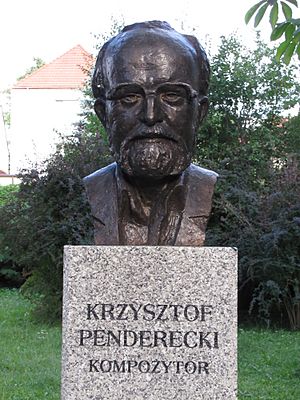
Krzysztof Penderecki's music continues to inspire many artists. A bronze bust honoring him was placed in The Gallery of Composers' Portraits in Bydgoszcz. There is also a monument to him in Kielce.
Even famous rock musicians were influenced by him. Led Zeppelin guitarist Jimmy Page admired Threnody to the Victims of Hiroshima. This inspired Page to use a violin bow on his guitar to create unique sounds.
Radiohead guitarist Jonny Greenwood also said Penderecki was a major influence. Greenwood even wrote a piece called 48 Responses to Polymorphia, which Penderecki himself conducted. Penderecki believed Greenwood helped introduce his music to a new generation.
Works
Penderecki wrote many different kinds of music, including:
- Operas
- Symphonies and other orchestral pieces
- Concertos for various instruments
- Choral works, often with religious texts
- Chamber music and pieces for solo instruments
Film and television scores
Between 1959 and 1968, Krzysztof Penderecki created original music for many films and animated shows. His music was often adapted for movie soundtracks, making his unique sounds known to a wider audience.
Honors and Awards
Penderecki received many important awards and honors throughout his life for his amazing contributions to music:
- 1959: Won the top three prizes at a competition for young Polish composers.
- 1961: Prize of the UNESCO International Tribune of Composers for Threnody.
- 1967: Prix Italia for the St. Luke Passion.
- 1968: Prix Italia for Dies Irae; Grammy Trustees Award.
- 1983: Wihuri Sibelius Prize (Finland).
- 1987: Wolf Prize in Arts (Israel); Grammy for Best Contemporary Composition.
- 1992: University of Louisville Grawemeyer Award for Music Composition.
- 1996: Primetime Emmy Award.
- 1998: Two Grammy Awards.
- 2001: Prince of Asturias Award for Art (Spain); Grammy for Best Choral Performance for Credo.
- 2004: Praemium Imperiale – Music (Japan).
- 2005: Order of the White Eagle (Poland).
- 2017: Grammy for Best Choral Performance.
He was also an honorary doctor or professor at many universities worldwide, including Yale University. He was an honorary member of several important music academies, like the Royal Academy of Music in London.
Images for kids
-
Krzysztof Penderecki and Władysław Bartoszewski in 2011
See also
 In Spanish: Krzysztof Penderecki para niños
In Spanish: Krzysztof Penderecki para niños
- List of Polish composers
- Music of Poland
- Lusławice


